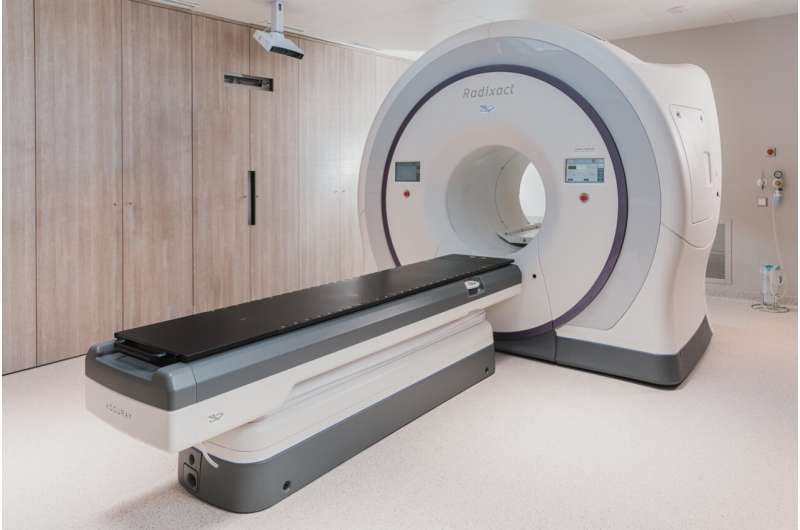This article has been reviewed according to Science X's editorial process and policies. Editors have highlighted the following attributes while ensuring the content's credibility:
fact-checked
trusted source
proofread
Virtual/augmented reality play set eases kids' and parents' anxieties ahead of MRI scan

Giving children a virtual/augmented (mixed) reality play set to use ahead of an MRI (magnetic resonance imaging) scan seems to ease both their and their parents' anxieties about this procedure, suggest preliminary findings published in BMJ Innovations.
Reducing the need to put a child to sleep, because of the noise and time required to keep still while in the MRI tunnel, could not only boost patient safety, but also cut costs and waiting times, suggest the researchers.
MRI has emerged as an important diagnostic tool in children's health care because of the high quality images produced and lower radiation exposure than CT (computed tomography) scanning, which is particularly important for children with long term conditions, they explain.
But the procedure can be lengthy, during which time patients must lie still. And it's very noisy—up to 80 decibels—requiring the use of ear protection, making it a challenging experience for many patients, especially children.
As a result, children are offered a general anesthetic for the scan. But recent research and safety concerns about the potential impact of anesthesia on a child's developing brain have prompted an initiative to reduce the number of MRI scans carried out under sedation.
It is widely accepted that play can reduce children's anxiety about medical treatment and procedures, and with that in mind, the researchers developed a play set to help 4–10-year-olds have an MRI scan without a general anesthetic.
They deliberately designed it to require the help of an adult, as parental anxiety can directly influence the level of a child.
The play set consists of a flat-packed cardboard kit for building into a small toy MRI scanner, into which the child can place their toy.
A smartphone slotted into the side of the cardboard MRI scanner enables the child to take on the role of the radiographer, via an augmented reality app. Augmented reality superimposes a computer-generated image on a user's view of the real world.
The child can then scan their toy with the addition of scanning noises to replicate the MRI experience. Afterwards, the child can swipe through various aspects of the real MRI images the radiographer plans to take.
The kit also includes an age-appropriate virtual reality cardboard headset, which—along with the app—allows the child to walk through the hospital virtually, culminating in him/her entering the MRI scanner itself.
The walkthrough includes four interactive games to prepare the child for various aspects of their journey, such as checking in, being weighed, removing magnetic objects from clothing and staying still for the scan itself.
The development of the play set was informed by primary school children's and parental feedback, and tested on 13 patients and their parents/caregivers.
This feedback indicated that the play set helped some children (and their parents/caregivers) to prepare for the MRI scan and that it also helped to relieve anxiety during the scan.
The children said that recalling aspects of the play set during their scan helped them to remain calm and still. Others said that the play set helped prepare them for what an MRI scanner would look like and the noise that it would make. Older children seemed to prefer the virtual reality aspects of the kit, while younger children were more drawn to the physical play and augmented reality aspects.
Both children and parents/caregivers said that they had previously felt anxious about the prospect of an MRI scan because of the unknowns involved. And the children suggested that they would like to have detailed factual information about the MRI scan.
As one child-parent pair found it difficult to build the mini cardboard scanner, the design may need further refinement, and the play set would need to be tested on much larger numbers of children both nationally and internationally, emphasize the researchers.
But they suggest that the kit has the potential to be adapted for use elsewhere: for example, to help prepare children coming into an admissions unit for planned surgery; during transfer to theater; and needling procedures.
"The development of the mixed realities MRI play set addresses a significant global problem within pediatric anesthesia and presents an opportunity for a change in practice to reduce the number of pediatric [general anaesthesias] and improve efficiency and resource usage within radiology and anesthetic departments," they write.
"The longest waiting list in radiology at our hospital is for MRI scans under [general anesthesia], and delays in performing scans lead to delays in diagnosis and treatment for children and their families, as well as increased usage of scanning time which further impacts the MRI waiting list," they elaborate.
"Additionally, a reduction in the requirement of [general anesthesia] for pediatric MRI reduces the need for an anesthetist, enabling their use elsewhere—for example, to help reduce the backlog in elective surgery waiting lists."
More information: Development and introduction of a mixed realities playkit: decreasing the incidence of general anaesthesia for paediatric MRI, BMJ Innovations (2023). DOI: 10.1136/bmjinnov-2023-001083




















